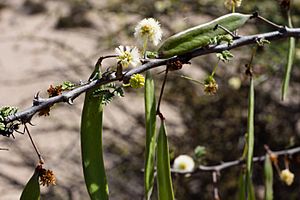Vachellia reficiens facts for kids
Quick facts for kids Vachellia reficiens |
|
|---|---|
 |
|
| Scientific classification | |
| Genus: |
Vachellia
|
| Species: |
reficiens
|
| Subspecies | |
|
|
| Synonyms | |
|
|
Vachellia reficiens is a special tree or shrub often called the red-bark acacia. People also know it as the red thorn or false umbrella tree. It belongs to the pea family, also known as Fabaceae.
This plant grows naturally in southern Africa. It often has a unique shape, looking like an upside-down cone with a fairly flat top. It loses its leaves during certain times of the year.
Contents
About the Red-Bark Acacia
The red-bark acacia was first described in 1859 by an Austrian scientist named Heinrich Wawra von Fernsee. He called it Acacia reficiens back then.
This tree is closely related to another tree called Vachellia luederitzii, which also grows in central and southern Africa. There are two main types, or subspecies, of Vachellia reficiens. One type, V. reficiens subspecies reficiens, is found in Angola and southwestern Africa. The other type, V. reficiens subspecies misera, grows in eastern Africa, from Sudan to Uganda.
What Does it Look Like?
The red-bark acacia can grow up to 5 meters (about 16 feet) tall. Its bark can be reddish-brown or greyish-black. It often looks rough with many cracks. Younger branches can have a purple-red color, which is why it's called "red-bark."
This plant has two kinds of thorns. Some thorns are long and straight, while others are shorter and curved like hooks. Usually, you won't find both types in the same pair. Its leaves are made up of many tiny leaflets, like most acacia trees in Africa. Each leaf has 1 to 4 pairs of branches, and each branch has 5 to 13 pairs of small leaflets.
The flowers are white or cream-colored. You can usually see them in December and January, which are summer months in southern Africa. However, they can bloom almost all year, depending on where the tree is growing. The fruit of the tree is a flat, reddish-brown pod.
Where Does it Grow?
You can find Vachellia reficiens in the drier parts of Africa. It grows in countries like Angola, South Africa, Eswatini, and Namibia. This plant prefers rocky soil and does not like areas with a lot of rain. It thrives in semi-desert and dry shrubland areas.
In Kenya, it is a very common tree in dry shrublands. In some areas, it makes up a large part of the tree cover. Sometimes, it can grow very thickly in savannas and woodlands. When this happens, it can crowd out other smaller plants.
Who Uses This Tree?
Many animals eat the leaves of the red-bark acacia. Large animals like the Greater Kudu and smaller animals like goats enjoy browsing on its leaves.
In some parts of Namibia and Kenya, this tree can grow very quickly. It can spread into farmlands, especially where the soil has been disturbed. Because it is very tough and grows easily, it can sometimes take over large areas of other native plants.
How People Use It
People in different parts of Africa use Vachellia reficiens in many ways. The Ngisonyoka people, who are nomadic, use its wood to build temporary homes in Kenya.
In Namibia's Kaokoveld region, people use the branches for fencing. The bark of the tree is used to curdle milk, which means making it thicker for cheese or yogurt. The thorns can even be used to pierce ears. The seeds can be baked, crushed, and mixed with tobacco to make snuff. The Giriama people use the wood for firewood and making charcoal. They also use the straight stems as poles for building.
See also
 In Spanish: Acacia de corteza roja para niños
In Spanish: Acacia de corteza roja para niños

